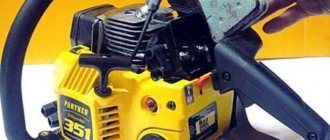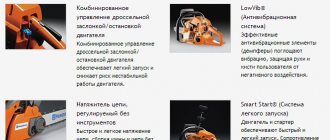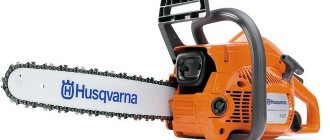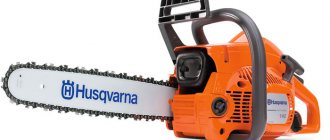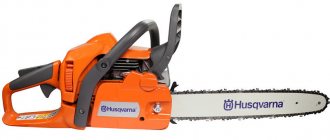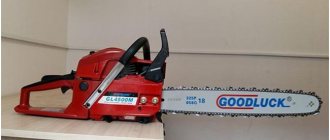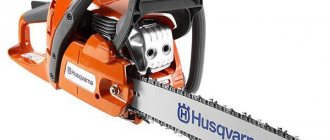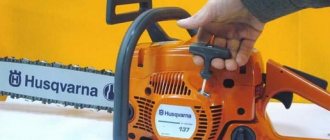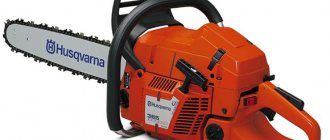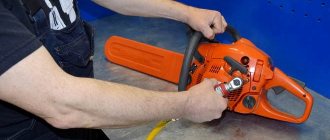Adjusting the carburetor of the Husqvarna 137 chainsaw with your own hands
Regardless of how often and under what conditions the 137th Husqvarna model is used, its proper operation largely depends on the timely adjustment of the standard carburetor. The
following malfunctions indicate the need for adjustment of this important unit:
- the chainsaw engine does not start;
- the engine starts and immediately stalls at idle;
- The internal combustion engine operates at idle and low speeds, but stalls at full throttle;
- Fuel consumption has noticeably increased and the volume of processed gases emitted by the engine has increased.
Setting up the carburetor of a Husqvarna 137 chainsaw yourself is quite simple if the operator adheres to the following algorithm of actions:
- First, the owner of the tool will need to set the factory settings of the standard carburetor. To do this, with a cold motor, you need to turn the screws in the manner indicated in the saw’s operating manual;
- Then you need to start the internal combustion engine of the chainsaw and wait a few minutes until it warms up;
- Next, you need to start turning the standard bolt marked “L” in the direction of the clock until the engine reaches its maximum operating speed. After this, screw “L” must be turned 1/4 turn in the opposite direction;
- The next step will require adjusting the idle speed of the Husqvarna chainsaw engine. To do this, you need to alternately turn the screw “T” in different directions until the chain stops on the bar. After this, you need to check the operation of the saw set - it should rotate only when you press the gas trigger;
- Then you need to adjust the engine power and its operation at maximum speed. To do this, you need to connect a tachometer to the built-in ignition system of the saw and set the maximum engine speed. Then the readings on the device must be compared with the instructions in the operating instructions. The indicators on the device and in the manual must match. Otherwise, you need to configure the operation of the chainsaw as required by the manufacturer.
https://youtube.com/watch?v=VOWwCeozRTY
Installation and preparation for work
The Husqvarna-137 modification was released in 2005. This is an ordinary household chainsaw. It is equipped with a powerful 2.2 horsepower engine and a 0.4 liter gas tank. The tool has an improved launch system. The manufacturer recommends using the original H30 tire (length ranges from 34 to 38 cm). For correct and safe operation of the unit, you must adhere to the appropriate operating rules:
- First, adjust the working (saw) unit.
- Lubricate the chain at idle speed.
- Fill with the appropriate fuel mixture.
- Use the starter to start the tool.
The saw should be run in for at least 10 hours. During this period, it is necessary to load the mechanism to a minimum so that all parts get used to each other. The starting system is equipped with a special spring that rotates the crankshaft during start-up, which greatly facilitates the starting process.
Chain
According to experts, the Husqvarna H30 chain is ideal for this model of chainsaws, which is characterized by a pitch length of 8.25 mm, a thickness of 1.3 mm and provides 64 links. During operation, it moves at a speed of 16.3 m/s.
During the operation of a chainsaw, questions may arise regarding chain sharpening, chain tension, problems with starting, and chain sharpening machines.
For better performance of the tool, the manufacturer advises having the chain sharpened by specialists. But you can determine the level of its tension yourself. Its adjustment is carried out using a screwdriver. To do this, turn the adjusting screw to the right or left a quarter turn.
Technical characteristics of the chainsaw
The Husqvarna 137 chainsaws are no longer produced today, as they have been replaced by the new, improved 236th model. However, in everyday life, almost every fifth farmstead still has such a device. In addition, for many he is a permanent assistant in the household. The device turned out to be so perfect that even the most picky critics found it difficult to name even one of its flaws.
Judge for yourself:
| Technical characteristics of the Husqvarna 137 chainsaw | |
| Country of origin and assembly | Sweden |
| Engine type | petrol |
| Type | household |
| Fuel tank volume | 0.41 l |
| Oil tank volume | 0.20 l |
| Engine capacity | 36.3 cm 3 |
| Engine power | 1.64 kW |
| Dimensions: -length -width | 33 cm 38 cm |
| Weight (without chain and bar) | 4.6 kg |
| Chain pitch | 8.25 mm |
| Chain thickness | 1.3 mm |
| Number of links | 64 pieces |
| Chain speed | 16.3 m/s |
| Idle speed | 3000 per minute |
| Tire length | minimum 33 cm, maximum 38 cm |
| Maximum tire end radius | 10T |
| Noisiness | 98 - 108 dB |
| Guarantee | 12 months |
Did you know? The world's first chainsaw with a gasoline engine, the Dolmar, was presented by German entrepreneur Emil Lerp. The tool was equipped with a 245 cm3 engine with a power of 8 hp. s., and weighed 58 kg.
When and why to adjust
The procedure for adjusting the carburetor is usually carried out quite rarely. The highest quality and best option is factory settings. But if necessary, it can be done by adjusting the corresponding screws. A carburetor in a chainsaw is necessary to prepare an air-gasoline mixture, which must have a certain ratio of ingredients. If the balance is not maintained, then malfunctions will begin to occur in the engine.
A mixture that does not meet specifications may be oversaturated or lean. In the first case, the amount of fuel relative to air is increased, in the second there is more air than needed, and less fuel. The article will discuss carburetor adjustment using the Husqvarna 142 chainsaw as an example.
Why does it stretch?
Saw owners often ask the question: “why does the chain on a chainsaw stretch?” Let's try to answer it. A saw set can stretch for several reasons.
- The oil pump is faulty or incorrectly adjusted. Limited or no oil supply results in excessive heat during operation. The hot chain stretches several times faster.
- Working in adverse conditions. Dust, dirt, and soil get on the headset during operation. The dirt particles act as an abrasive material and gradually rub the joints of the links, causing it to stretch.
- Using poor quality chain lube. Often, the oil used to lubricate the chain is not the oil recommended by the manufacturer, but used oil from the car engine. The “working off” contains metal particles, which can also give the effect of an abrasive material.
- The chain is new. Manufacturers of chainsaws specially make adjustment screws on the saw, since the stretching process is inevitable.
- Natural stretching as a result of prolonged work.
Stretching is inevitable, the question is how quickly it will happen. You can extend the service life by using high-quality lubricating oils, carrying out timely diagnostics of the oil pump and taking breaks in operation.
Such measures can significantly reduce the likelihood of sprains, but not completely eliminate them.
Adjusting the carburetor of the Husqvarna 137 chainsaw with your own hands
Regardless of how often and under what conditions the 137th Husqvarna model is used, its proper operation largely depends on the timely adjustment of the standard carburetor
The following malfunctions indicate the need for adjustment of this important unit:
- the chainsaw engine does not start;
- the engine starts and immediately stalls at idle;
- The internal combustion engine operates at idle and low speeds, but stalls at full throttle;
- Fuel consumption has noticeably increased and the volume of processed gases emitted by the engine has increased.
Setting up the carburetor of a Husqvarna 137 chainsaw yourself is quite simple if the operator adheres to the following algorithm of actions:
- First, the owner of the tool will need to set the factory settings of the standard carburetor. To do this, with a cold motor, you need to turn the screws in the manner indicated in the saw’s operating manual;
- Then you need to start the internal combustion engine of the chainsaw and wait a few minutes until it warms up;
- Next, you need to start turning the standard bolt marked “L” in the direction of the clock until the engine reaches its maximum operating speed. After this, screw “L” must be turned 1/4 turn in the opposite direction;
- The next step will require adjusting the idle speed of the Husqvarna chainsaw engine. To do this, you need to alternately turn the screw “T” in different directions until the chain stops on the bar. After this, you need to check the operation of the saw set - it should rotate only when you press the gas trigger;
- Then you need to adjust the engine power and its operation at maximum speed. To do this, you need to connect a tachometer to the built-in ignition system of the saw and set the maximum engine speed. Then the readings on the device must be compared with the instructions in the operating instructions. The indicators on the device and in the manual must match. Otherwise, you need to configure the operation of the chainsaw as required by the manufacturer.
https://youtube.com/watch?v=VOWwCeozRTY
Immediately after setting up the carburetor, you need to check the operation of the engine. To do this, you need to start the garden tool and sharply press the gas trigger several times. If the engine accelerates sharply when you press the trigger, it means that the unit has been configured correctly.
How to choose a chainsaw is not an easy question; the range of products is simply huge, so many people have difficulties when purchasing this product. After all, you want to not only buy a chainsaw for yourself, but also invest your money profitably and buy a truly reliable and practical thing
If you decide to acquire this type of equipment, and do not know what to look for first when purchasing, then this article is just for you. Here you can find answers to your questions regarding the technical characteristics of one of the most popular models among chainsaws - Husqvarna 137
This is an “amateur” version of a chainsaw; a more professional one is the shtil chainsaw. In this article we will talk about the causes of saw malfunctions and their repair.
How to dilute gasoline for a Husqvarna chainsaw
For productive work and increased service life at high power, maintain the proportion of oil and gasoline for the chainsaw, measuring the ratio of the ingredients of the fuel consistency with a measuring tank. When producing even a small quantity, a small incorrectness affects the quality of the fuel.
For dilution, use high-quality gasoline with the lowest octane number - RON 90. If the parameter is less than recommended, the engine begins to knock, which leads to overheating and increased load on the bearings. When operating at high speeds the same, choose gasoline with an increased rating.
It is recommended to use 2-stroke oil.
To properly dilute gasoline for a chainsaw, use the following mixing scheme:
- for engines with a cylinder displacement of up to 80 cm³ - 1:50 (2%), i.e. 5 liters of gasoline - 0.10 liters of oil;
- for engines with a volume above 80 cm³ - 1:33 (3%), i.e. 5 liters of gasoline - 0.15 liters of oil.
If it starts and stalls
The Husqvarna chainsaw starts and stalls when you press the gas. This is caused by a clogged carburetor jet and a dirty fuel tank filter. The disadvantage is eliminated as follows:
- disconnect the fuel hose from the carburetor;
- create an inspection of water leakage - the breather is clean if a full stream comes out.
The next reason why a chainsaw is contamination of the muffler with exhaust resins. The issue can be resolved by cleaning.
Wear of piston rings affects the operation of the cylinder-piston group. If there is free play, parts are replaced during inspection.
When starting the engine, the unit may also stall:
- as a result of water entering the mixture;
- due to weak chain lubrication;
- oil wire leakage;
- clogged channels.
- if dryness increases, clean the oil supply channels, inspect the elements connecting the fittings to the tubes;
- If there is an oil leak at the connecting points or there are cracks in the tubes, they are sealed with sealant.
- if the piston rings burn in the grooves;
- when the crankcase rubber seals wear out and lose elasticity;
- leaks in the connection between the cylinder and the crankcase;
- due to incorrect setting of the ignition timing;
- as a result, contamination of the cylinder fins and fan grille;
- under heavy load immediately after purchasing a new motor.
Device
The product has a classic design for products of its class. Manufacturers have embodied simplicity and sufficiency in it.
Construction of the Husqvarna 137 chainsaw:
- frame;
- holding handles;
- mechanical starter;
- internal combustion engine;
- chain brake lever;
- tanks for oil and fuel mixture;
- throttle, gas and choke control levers;
- ignition button;
- muffler;
- sprocket tire;
- saw chain.
The fuel supply system and clutch are mounted inside the housing.
Carburetor
The unit is responsible for supplying a mixture of fuel and oil to the cylinder. The carburetor is equipped with a diaphragm and a special needle valve. These parts regulate the pressure in the system. The dosage of the supplied air is carried out by two dampers located on the diffuser chamber. One regulates the air volume when pressing the gas lever, and the second regulates the flow during a cold start of the tool. At this moment, the damper partially closes, and the enriched mixture enters the engine.
After mixing gasoline and oil, the fuel is supplied to the cylinder through an injector with a check valve. This is an important detail that prevents exhaust gases from entering the diffuser.
The chain for the Husqvarna 137 chainsaw is different:
- high strength;
- hardness;
- low vibration;
- wear resistance.
The drill links are equipped with chamfers that ensure high-quality cutting of hardwood.
Saw chain characteristics:
- link thickness - 1.3 mm;
- chain pitch - 3/8 inch;
- tire length - 40 cm;
- number of links - 56.
The product uses the “chisel with chamfer” technology. The tension is adjusted with a screwdriver by turning the adjusting screw. Sharpening is carried out with a round needle file with a diameter of 4 mm. An alternative is to use a sharpening machine or the services of specialists from a service center.
Preparatory stages, starting the chainsaw
A properly prepared fuel mixture is the key to proper operation of a chainsaw. For a high-quality mixture, take:
- unleaded gasoline with an octane rating of 90 to 93, no more and no less);
- motor oil for two-stroke internal combustion engines of the Husqvarna brand.
The recommended ratio of technical fluids is 50/1. When the mixture is prepared, you can proceed to other actions:
- The saw is getting ready.
- The saw set is mounted, the chain is tensioned.
- A mixture of gasoline and oil and chain oil (from Husqvarna) are poured into the tanks.
- The chainsaw starts.
- The functionality of the chainsaw is checked: the brakes are activated, idling and splashing of lubricant.
Adjusting the carburetor of the Husqvarna 137 chainsaw with your own hands
For the efficient operation of Husqvarna 137, correct carburetor settings are very important. This tool assembly must be adjusted in cases where the saw does not start, is unstable, or consumes a significant amount of fuel.
In this case, you will need to perform the following steps:
- First, you will need to install the saw on a flat surface and lay it on its side;
- After this, you need to turn the screw all the way, which regulates the engine idle speed;
- Next, you will need to turn this screw 4.5 turns counterclockwise. After this, you need to make sure that while the motor is running in this position of the screw, the saw chain does not rotate;
- If the saw chain moves along the bar, you need to continue turning the screw slowly. Each time it is re-checked, it must not travel more than 1/16 of a turn.
Problems with the fuel supply system
If the tool does not work, it may be due to the fact that there is no fuel entering the cylinder.
First of all, you need to check the fuel filter for contamination levels. To check this, you need to remove the fuel hose and check how fast the fuel flows.
If it is supplied under low pressure, then the problem lies in the filter.
In this case, you need to clean the filter. It is taken directly through the tank. The filter is cleaned and installed back. It is washed under running clean water.
After this, the filter is dried and carefully installed back. To prevent this problem from occurring in the future, it is necessary to periodically clean the filter.
If cleaning the filter does not give a positive result, then you should pay attention to the breather. A clogged hole in this hole causes insufficient air to enter the carburetor.
Technical and technological features
To increase productivity, operational reliability and durability, higher quality materials are used in the production of the chainsaw range. Also experience in successful implementation of past developments, own design solutions.
Only by purchasing the original can you have full confidence that the power and other properties of the Husqvarna chainsaw model 142 will cope with transverse, diagonal or longitudinal sawing of all types of wood up to 30 cm in diameter.
- These characteristics determine the suitability of the tool for harvesting wood fuel, cutting timber, and forming crowns of ornamental and garden trees.
- The ability to operate the saw with tires that are smaller and more comfortable for working in inaccessible places determines the suitability of the tool for the construction of wooden structures for special and general purposes.
- Working with a saw does not require professional qualifications; the necessary abilities are quickly acquired during the work itself.
Replacing a sprocket on a Husqvarna 137 chainsaw
Often the reason that the Husqvarna 137 chainsaw stalls is the need to replace the clutch sprocket. This procedure is performed in this order:
- First, remove the entire saw set - the bar, chain and nuts should lie to the side;
- Then remove the air filter and unscrew the spark plug;
- Instead of a spark plug, insert a piston stopper;
- Remove the clutch, freeing passage to the internal space;
- Carefully inspect the drum. After this, replace the sprocket, springs and cams;
- Next, use a universal key to tighten the clutch mechanism in a counterclockwise position;
- Then assemble the chainsaw, remove the piston corkscrew and screw the spark plug into its place.
Starter repair
The starter is responsible for starting the unit. Malfunctions indicate the presence of the following defects:
- the spring burst;
- the pulley is damaged;
- the starting cable is damaged.
Sequence of actions for replacing a worn starter cord:
- the starter is disassembled, the mechanism is removed, having previously unscrewed the screws securing the housing to the engine crankcase;
- the cord stretches at a distance of 30 cm through the hole in the pulley;
- the return spring is set to the neutral position;
- the central screw is unscrewed and the pulley itself is removed;
- a new cord is inserted, tensioned, and 3 turns are wound around the mechanism and secured with a screw;
- then the cord is pulled through the groove in the starter housing and handle.
The return spring is tensioned by rotating it 2 turns clockwise, taking into account that it is compressed. When replacing a broken part, the spring should pop out after pulling its inner part down.
DIY chainsaw carburetor repair instructions
A chainsaw is needed in construction, gardening, and landscaping - its presence greatly simplifies the performance of a number of wood processing tasks. The main component of this tool is the engine, the operation of which largely depends on the condition and settings of the carburetor. This is where the fuel mixture is prepared. This means that if the saw does not start, stalls, or does not provide the required power, it is likely that the reason for this is improper operation of the carburetor. Fortunately, in many cases you can deal with this on your own. Only for this you need to know and understand the structure and operating principle of this unit and, of course, the chainsaw itself.
Classic chainsaw layout
Almost all professional and amateur chainsaws are equipped with two-stroke air-cooled gasoline engines.
This assumes the presence of at least one cylinder with heat sink fins. The fuel supply system (carburetor) performs the function of a gasoline-air mixer. Dirt, dust, and shavings should not enter the working combustion chamber along with the fuel mixture, and filters are installed on the saws to clean the supplied air. Manufacturers recommend changing the filter once per season. In the interval between replacements, it must be cleaned once every 10-15 refills.
For convenience and ease of starting the internal combustion engine, any chainsaw is equipped with a starter, which is a reel with a wound cable and a handle. Even the most powerful Husqvarna chainsaw is equipped with a sophisticated starting mechanism.
In order to reduce the vibration transmitted to the feller's hands, a special device is installed on the tool. In addition, this mechanism prevents the tire from “driving” while cutting wood.
Model features
The Husqvarna 137 chainsaw is designed in such a way that all resources maintain maximum performance over a long period of time:
- The AutoTune option makes it possible to use automatic carburetor adjustments.
- When air enters, secondary filtration occurs, reducing the load on the filter.
- Vibration damping is due to the LowVib function.
- An easy start option is provided, thanks to which the engine of the Husqvarna 137 chainsaw operates uninterruptedly in any season.
- The chain tensioner is located on the side of the housing.
- For various, private adjustments and repairs, a universal key is used.
- The driven sprocket is equipped not only with an automatic lubrication system, but also with an auxiliary hole for receiving lubricants.
Checking the spark plugs
The first step is to check the spark plugs. You need to disconnect the wire that goes to the latter and unscrew it with a special key. Based on the condition of the spark plug, you can determine possible problems:
- a dry spark plug indicates that there is no access of the incendiary mixture to the cylinder; the ignition system has nothing to do with it. The cause of the breakdown may be a clogged conductive tube or a problem with the carburetor. It is necessary to clean the fuel line and check the functionality of the fuel pump and carburetor. If one of the mechanisms does not work, it is necessary to replace it with a new one, since repairing the latter is impossible in the absence of professional skills;
- A wet spark plug indicates an excess of fuel mixture in the cylinder or water getting into it. It is necessary to dry the spark plug, remove any remaining liquid and blow out the cylinder chamber - with the fuel supply turned off, start the starter. Then you should put the spark plug on and start it again. When checking, you need to measure the gap between the electrodes; an indicator from 0.5 to 0.65 mm is considered acceptable. In case of damage or signs of abrasion, the gasket must be replaced. If after the above operations the spark is good, there may be a problem with the quality of gasoline. Absence or unevenness is an ignition problem. There is a possibility of damage to the supply wire or spark plug. If the new spark plug does not respond, it is necessary to inspect the starting system in more detail;
- a spark plug with a black coating of soot is evidence of the possible use of low-quality lubricant, an imbalance in the “gasoline-oil” balance in favor of the latter, or a clogged one of the filters. Clogging leads to a loss of power of the chainsaw and its subsequent stoppage. The dust does not burn completely and settles on the cylinder walls as a layer of black soot. You need to change the fuel, clean the fuel filter, wash and dry the air filter. Remove soot from the candle using an awl or needle, and clean the contacts with medium-sized sandpaper.
Adjusting the Husqvarna chainsaw carburetor
Like all other saws, Husqvarna has the same carburetor adjustment algorithm. Therefore, the instructions will be relevant for other tools and models of chainsaws such as Husqvarna 142, 236.
Before starting work, make sure the air filter is clean and all other components are working properly. The fuel supply to the float chamber should operate without interruption, and the ignition system is set correctly and has a fresh spark plug.
Procedure:
- Reset the carburetor to factory settings. This must be done with the engine stopped.
- Now you can start the engine and be sure to warm it up for several minutes. Adjustment of the XX carburetor Husqvarna 137 is carried out only on a warm engine.
- By rotating screw L clockwise, you need to set the crankshaft speed to the highest speed, then turn it back a quarter turn. Use screw T to adjust the crankshaft speed so that the chain does not rotate. It should not be driven without pressing the accelerator.
- Now you need to set the maximum speed and its power. It is enough to connect the tachometer to the ignition system and use the accelerator to set the maximum possible speed. Compare them with your passport data. If they differ, then unscrew or tighten screw H. By changing the range, you can create restrictions to make the saw work efficiently and save the life of the motor.
What you should pay attention to?
Once the adjustment of the Husqvarna carburetor is completed, you need to make sure that the engine is stable and that the saw easily picks up and drops the required speed. The rotation of the chain at idle is considered abnormal, so its connection with the clutch must be adjusted again using screw H.
Do not forget that the unit is not adjusted immediately: you need to wait some time, since the Husqvarna chainsaw does not immediately respond to changes in the position of the screws. This time can range from 5 to 15 seconds. This time is not indicated in the table, so you can only find out experimentally.
If after adjustment a huge amount of smoke appears during operation, then you need to adjust the supply of the fuel and oil mixture. For these purposes, rotate screw L.
What is the factory setting of the Husqvarna chainsaw carburetor?
To ensure that the chainsaw still starts even if the settings are incorrect, the factory positions of the screws H and L are used. Most Husqvarna chainsaws can be started if both screws are unscrewed exactly one and a half turns. Only after this can the screw positions be changed in order to achieve the desired fuel consumption and maximum operating efficiency. XX is also regulated after these manipulations.
If you still have questions about adjusting the carburetor on the Husqvarna 137 chainsaw and other models in this line, I recommend watching this video:
Maintenance of the Husqvarna 137 petrol chain saw
What is meant by chain saw maintenance? This is, first of all:
- Cleaning air and fuel filters.
- Spark plug maintenance.
- Control of the brake mechanism.
- Chainsaw carburetor repair.
- Cleaning oil-conducting tubules.
- Cleaning the chainsaw from chips and dirt.
- Replacing a sprocket on a chainsaw.
- Checking the reliability of fastenings.
- Sharpening the chain.
- Saw bar maintenance.
- If necessary, adjust the ignition.
Proper preparation for storage
Newly-minted equipment owners are interested in the following questions:
- how to adjust the carburetor on a Husqvarna 137 chainsaw;
- where is the breather located on the Husqvarna 137 petrol chain saw;
- how to change a sprocket on a chainsaw, etc.
Carburetor adjustment
After break-in, some chainsaw owners adjust the carburetor. It consists of several stages:
- Start the saw and turn the high and low speed adjustment screws until they stop. Unscrew it back 1.5 turns;
- Warm up the saw for about 10 minutes. Set the idle speed using the idle speed screw. With the correct settings, the chain will not move along the bar at idle;
- Check the saw for acceleration. When you press the accelerator, the speed should increase quickly.
Before you start adjusting the carburetor on your chainsaw yourself, we suggest watching a video that shows how to properly disassemble the Husqvarna 137 chainsaw and how the adjustment itself is made.
Husqvarna saw disassembly algorithm
The process of disassembling a Husqvarna chainsaw is quite simple. In order to do everything correctly and not break parts of the housing or CPG, it is necessary to disassemble in the following order:
- Top cover.
- Chain and saw brake cover.
- Starter.
- Flywheel and clutch.
- Front handle.
- Carburetor.
- Oil pump.
- Engine.
Depending on the Husqvarna model, the disassembly procedure may vary slightly.
Important: before you start disassembling the chainsaw, you need to clean it. When working with a saw, a lot of chips and wood dust are generated, which during disassembly can get into the internal parts of the Husqvarna chainsaw
Removing the side cover and saw set
The side cover, or also called the saw chain brake cover, is held in place with two thirteen nuts.
After unscrewing the nuts, the cover is removed from the guide pins, after which you can remove the bar and chain from the chainsaw. Some models of Husqvarna saws have a special mechanism installed that allows you to dismantle the cover and saw set without the help of special tools.
Starter
The starter is located on the right side of the Husqvarna and is held in place by several screws. By unscrewing them, you can easily remove the starter and thereby gain access to the flywheel and ignition coil.
Removing the flywheel and clutch
In order to unscrew the flywheel nut, you need to unscrew the spark plug and install a piston stopper in its place.
Once the piston stopper is installed in the cylinder, the flywheel nut can be loosened. After the nut is unscrewed, it is necessary to use a hammer and a drift made of soft material to apply one sharp blow, installing the drift on the flywheel mounting shaft. This is necessary to remove the flywheel from the shaft, since the design provides for the installation and tightening of this element with great force.
You can learn more about how to properly remove the flywheel from a Husqvarna chainsaw, as well as how to completely disassemble the saw by watching the video. The wizard explains the entire process step by step and demonstrates all the necessary tools:
In order to unscrew the clutch you will need a special key. If there is no key, then it can be made from an old twenty-two head, grinding it in a certain way using emery.
Do not try to unscrew the clutch with a hammer and chisel, as some craftsmen advise. Using these tools, you risk breaking the clutch housing and increasing repair costs. It can also damage the crankshaft bearings.
Removing the Husqvarna front handle is quite simple, as it is attached to the shock absorbers with screws.
Air filter and carburetor
To remove the carburetor, it is necessary to disconnect the fuel hose and damper rods from it; this can be done conveniently after the air filter is removed, which is installed immediately behind the carburetor and held in place with two 10mm nuts. After the air filter is removed, the fuel hose and the rods are disconnected, just pull the carburetor towards you and remove it from the studs.
Oil pump
On Husqvarna, the oil pump is installed on the right side of the chainsaw. It can only be removed after the clutch has been released. Removal does not require a special tool, because... The fastening screws are made for a regular Phillips screwdriver. After the screws are unscrewed, it is necessary to lift the pump and disconnect the oil hoses from it.
Engine
To remove the engine on a Husqvarna chainsaw, after the carburetor, clutch, flywheel and muffler have been removed, you will need to unscrew the four screws securing it to the body.
After the engine is removed, you can unscrew the ignition coil from it, remembering to first disconnect the wires leading from it to the ignition switch. The coil can also be removed immediately after the starter is removed.
Assembling the Husqvarna chainsaw should be carried out in the reverse order, and the flywheel nut and clutch must be tightened with the force specified in the chainsaw operating instructions.
Tension algorithm
Before tightening the chain on a chainsaw, you must turn off the engine of the unit, or unplug it from the mains if it is an electric saw. Do not adjust or replace the saw element while it is hot. If this is done, the metal will shrink after cooling and the tension will be too great, which can lead to increased load on the engine and deformation of the tire.
The chain tensioner is located on the right side of the unit, under the cover, in the place where the brake and clutch are installed and the tire mount is located. On Husqwarna, STIHL, Poulan and Partner chainsaws, the external tensioner looks like an ordinary bolt.
So, to configure the chain element of the device, you need to perform the following steps.
- Slightly loosen the nuts located on the right cover so that the tire does not become distorted.
- After inserting a screwdriver into the tensioner adjusting bolt, begin to rotate it to the right (clockwise). These actions will cause the tire to start moving and the chain will be tensioned. If you rotate the bolt to the left (counterclockwise), the chain links will relax.
- Next, you should tighten the chain until it does not sag or dangle.
- Check the tension of the element: grab the cutting link approximately in the center of the bar and pull it down with a little force. The chain must be tensioned, have elasticity, and the shank of the cutting link must fit into the groove of the bar at approximately 1/3 of its height.
On the Makita electric saw, the tension regulator is designed in such a way that it can be turned without the use of any tools. By rotating it clockwise, you will tighten the chain ; if you rotate the adjuster in the opposite direction, the tension of the chain element will weaken.
Chainsaw malfunctions and their elimination
There are typical faults that owners of the Husqvarna 137 model most often encounter. In order to be able to fix them yourself, you need to study the signs of their occurrence and effective methods for repairing them.
The chainsaw stalls at full throttle - how to solve the problem?
The cause of this breakdown is most often the spark plug flooding at the moment when the engine begins to quickly gain speed. To fix the damage, you should unscrew and clean the spark plug, and then dry it completely. Next, you need to drain the remaining fuel through the spark plug hole. At the end, you need to screw the spark plug back into place and try to start the tool again.
Another common cause of failure is lack of spark. Repairs should begin by inspecting the contact between the high-voltage wire and the tip of the spark plug. If the contact is not broken, and the saw still stalls when you press the gas, then you should inspect the electronic ignition unit. This unit cannot be repaired, so it will have to be replaced entirely.
Replacing the Husqvarna 137 sprocket
It is necessary to change the Husqvarna 137 sprocket if, when the engine reaches medium speed, the engine begins to stall.
As indicated in the operating instructions, the procedure should look like this:
- First you need to remove the cylinder cover and unscrew the spark plug;
- Next, you need to take a plastic or metal stopper for the motor piston, as well as a key for dismantling the centrifugal mechanism. Using a key, you need to twist the centrifugal mechanism in the direction in which the chain rotates;
- Then you need to inspect the clutch disc. If only the sprocket is faulty, then only it needs to be replaced. If the entire clutch disc is completely broken, along with the springs and cams, then the entire disc will have to be replaced;
- After this, you need to install a new clutch disc. To clamp the centrifugal mechanism on the motor shaft, you will need to unscrew the piston stopper and pull the starter cord towards you. Then you need to screw the stopper all the way;
- Next, you will need to clamp the centrifugal mechanism with a key in the direction against the rotation of the chain.
After completing all of the above steps, you will need to start the saw and let it idle for 1-2 minutes. This is necessary to warm up the engine and grind in the new clutch disc. You can then continue working with the tool.
What to do if the chainsaw continues to not start?
If the initial inspection did not yield anything or the defects were eliminated during the search process, but the chainsaw still does not start, then you need to look for more serious reasons. It is best to identify and repair such breakdowns at a service center. However, if you have experience, you can find and eliminate them yourself. What to diagnose and check?
- Compression in the cylinder;
- Compression in the crankcase;
- Carburetor operation.
In the first case, checking the compression in the cylinder will allow you to find out the condition of the cylinder-piston group (CPG) of a chainsaw that does not want to start when cold. To do this you need a compression gauge. The device is screwed into place of the spark plug and the engine is started idle. Measuring the readings allows you to judge the condition of the CPG. In the absence of a compression gauge, you can determine the compression in the cylinder offhand as follows:
- Place your finger on the spark plug hole;
- Try to start the chainsaw engine.
By placing your finger on the spark plug hole and pulling the starter, you can check the compression in the cylinder
If you feel that your finger is being pulled strongly into the spark plug channel, then everything is in order with compression. The absence of vacuum in the chamber indicates a malfunction. The cylinder-piston group needs a more detailed inspection, which will give an idea of the condition of the piston and cylinder, piston rings and bearings.
A chainsaw may not start when cold due to a lack of compression in the engine crankcase. The main reason for this is damage to the gasket located between the cylinder and the crankcase. It is quite easy to detect a lack of compression:
- Disconnect the upper tube from the carburetor;
- Pour gasoline into a regular cork;
- We immerse the removed tube in the fuel;
- We pull the starter several times.
Setting up the carburetor of a Chinese chainsaw
Almost any Chinese chainsaw has the same adjustments as its branded counterparts. The same screws L, H and T are present. There are saws in which only the idle speed can be adjusted. Then the factory settings of the Husqvarna chainsaw chainsaw carburetor. However, according to reviews from owners who are not service workers, not every chainsaw can easily adjust the carburetor. Adjusting the carburetor of a Husqvarna 240 chainsaw. Even for experienced repairmen, some models will certainly take a decent amount of time until they get an acceptable result.
The standard position for “Chinese” carburetors is the position of the screw L, at which} {it is loosened by one and a half turns from the fully clamped position. For screw H - one turn from the correct selection of the studio of the same state. In numerous videos, screw L is called adjusting the quality of the mixture, and screw H is its quantity. The idle speed is adjusted in the same way as described above on a warm engine.
Clutch drum bearing
Another chainsaw assembly that is subject to high loads is the clutch drum (cup), which includes the chain drive drive sprocket. Although the clutch drum bearings only work at idle speed of the chainsaw (when the throttle is open, the drum rotates at the speed of the crankshaft), high loads are placed on it - so cage-type needle bearings or without an inner ring are used here. Such bearings require regular lubrication and, even with careful care, require periodic replacement - usually along with the drive sprocket.
For STIHL chainsaws of models MS 170 - 311, 390, 391, a proprietary clutch drum needle bearing with dimensions of 10 * 13 * 10 mm is used. Interestingly, the same size needle bearings are used in the Echo CS2600, 2700, 3050, 260TES, 270WES chainsaws, as well as the Shindaiwa 452S-15 and some Champion models. Compatible bearings are produced by the Oregon brand. In addition, the range of the well-known brand INA-FAG includes a needle bearing K101310 with the same dimensions, which is used as a replacement for branded products that are not always available in Russian regions.
Experts, a leading supplier of industrial bearings in Russia, note that for most branded bearings that are used in chain saws, it is easy to find equally high-quality and reliable analogues from leading Western brands - such as Timken, NTN-SNR or NSK
However, in order for them to work for the period allotted to them, it is important to follow the installation and dismantling technology, to prevent deformation and excessive heating when seating on the axle
You can purchase bearings from leading Western brands for chain saws, as well as lawn mowers, trimmers and power tools bearings in Podshipnik.ru offices in Moscow, St. Petersburg, Belgorod, Volgograd, Voronezh, Voskresensk (Mos. region), Yekaterinburg, Krasnodar, Krasnoyarsk, Kazan, Elabuga, Lipetsk, Maikop, Naberezhnye Chelny, Nizhny Novgorod, Novosibirsk, Omsk, Penza, Perm, Rostov-on-Don, Simferopol, Stavropol, Tula, Ryazan, Samara, Saratov, Ulyanovsk, Ufa, Chelyabinsk, Yaroslavl.
You can check the availability and cost of imported bearings for chain saws, lawn mowers, trimmers and power tools in a warehouse in Moscow, and also order their delivery anywhere in Russia by phone or email
Types of clutch failures
The types of faults do not depend on the chainsaw model, since the structure and principle of operation of the clutch is the same on almost all modern power units. Chainsaw operators know that a minor problem with this unit requires immediate action. Breakdowns are inevitable, since the clutch collides with less intensive use of the tool with a heavy load. Often problems are related to:
- wear of the assembly as a whole (the spring may burst or the mechanism may begin to slip);
- spring damage (the chain will rotate, the engine will work, but is unstable);
- chips have formed on the clutch cam due to heavy load or overheating (just listen to the unit while it is operating; extraneous noise indicates a malfunction).
Whatever the reason for poor performance of the clutch and related components, you will need to remove the clutch to repair it.
Please note that repair work does not always give the desired result, so sometimes you need to replace the clutch on a chainsaw. All of the above manipulations can be “performed” independently, without turning to service center specialists for help.
How to remove the clutch on a chainsaw?
It is not necessary to review the instructions for this type of work for a particular model, because all use one universal one, which allows dismantling this unit on modern gas-powered tools.
If there are any distinctive nuances, they relate to individual clutch parts. For example, some brands create one spring with two sections in the design of this assembly, which must be taken into account when completely replacing this component (it must be replaced when the spring is damaged, due to which the chain will rotate and the engine will exhibit unstable operation).
Chainsaw piston group
The dimensions of the cylinder-piston group are determined primarily by the diameter of the piston, made of heat-resistant aluminum alloy. Regardless of the model, the chainsaw CPG consists of a cylinder, a piston, a holding pin and two clamps.
Chainsaw cylinder mirror
When purchasing a piston
chainsaws, you should pay attention to the inner surface of the cylinder, which should be polished and have a glossy shine. If there is damage or scratches, experts do not recommend installing such a cylinder.
In order to increase compression in the working unit and, as a result, increase power, many manufacturers install two piston rings. The chainsaw's compression rings, made of special cast iron, fit tightly to the cylinder, resulting in the tightness of the combustion chamber.
How to correctly install a piston on a chainsaw
Sources:
https://prokarbyrator.ru/regulirovka-karbyuratora/regulirovka-karbyuratora-benzopily-huskvarna-137-svoimi-rukami.html https://profistroy74.ru/instrumenty/kak-sobrat-porshnevuyu-na-benzopile.html
How to change the sprocket?
If you need to replace the sprocket on a Husqvarna 137 chainsaw, you will need to perform the following algorithm:
- Open the side cover giving access to the tire and sprocket.
- After loosening the chain, you need to remove the tire.
- Once the sprocket is free, unscrew the spark plug to gain access to the engine piston.
- You need to rotate the sprocket manually.
- The piston is brought almost to the highest point of the channel.
- The resulting hole must be filled as tightly as possible using a soft candle cord. This will block the movement of the piston.
- To unscrew the sprocket, use an open-end wrench.
Replacing the sprocket on a Husqvarna chainsaw is done as carefully as possible so as not to damage the mechanism components
Regardless of whether you repair the Husqvarna 137 chainsaw with your own hands or entrust this process to professionals, pay attention to the quality of the spare parts used
About malfunctions
If you have finally made your dream come true and purchased for your farm such an indispensable assistant as the Husqvarna 137 chainsaw, then it’s time to familiarize yourself with all possible breakdowns and methods for eliminating them. After all, as they say, you need to be prepared for anything and a breakdown can occur at the most inopportune moment. Today, there are a huge number of workshops that repair this type of equipment, but it takes time to get your chainsaw in working order and you will also have to pay a certain amount for the service.
But, you must agree that it is much more economical and easier to repair the Husqvarna 137 chainsaw with your own hands. In fact, if the damage is not significant, then there is no point in spending money, and you can easily fix the damage. And so that in such cases you at least have an idea of what’s wrong with your instrument and how to perform “first aid,” below we will provide all the most common malfunctions and instructions for repairing Husqvarna 137.
In this video you can see disassembly instructions:
The device does not start - the ignition system is faulty
If you encounter a chainsaw malfunction, the first thing to do is check the spark plug. But this must be done very carefully, using a special hook after first disconnecting the wire
The most important thing you should pay attention to is the appearance of the candle itself.
Causes of failure
A dry surface indicates that fuel has stopped flowing into the cylinder, therefore, the problem of failure is not in the spark plug, so it needs to be screwed back in.
But if the spark plug is covered with fuel splashes, this indicates that the problem is either in the carburetor, which was not adjusted correctly, or the starting rule was violated.
Troubleshooting
In order to eliminate this kind of problem, you need to thoroughly wipe the spark plug, turn off the fuel supply and turn on the starter. This is done in order to ventilate the combustion chamber and get rid of excess fuel. After which the cleaned spark plug must be put back in place and the chainsaw started. And the last thing that can happen to a candle is that it can be covered with soot, which indicates that you are using low quality oil, which is not acceptable if you want the tool to serve you for many years. Also, the reason for this may be an error in calculating oil and gasoline, and an incorrect carburetor adjustment process.
In this case, you must clean the spark plug by rinsing it and using an awl to remove any carbon deposits, then wipe the electrodes with sandpaper and install them in place. In addition, it is important that the gap directly between the electrodes and the spark plug should not exceed 0.5 - 0.65 mm, otherwise it is necessary to install a new gasket.
It is important to pay attention to whether there is a spark. For this kind of manipulation you need to put the ignition cable directly on the spark plug, then connect the cylinder and the nut located on the spark plug using pliers and start the starter
After which sparks should appear, but if they are absent, then the problem is that the chainsaw is faulty in the spark plug, which needs to be replaced. But there are times when even after replacement there is no spark, this indicates that the high-voltage wire is faulty or the direct connection to the spark plug is broken.
Husqvarna-236
This model replaced the much-loved 137.
Having slightly less power (1.4 kW), it added 100 g in weight, gained a 40-centimeter saw bar and, most importantly, a new engine, 20% more economical than its predecessor, with higher torque and a wider speed range, which did the job with this saw it is even more comfortable and has slightly expanded the range of its applications.
True, its cost has increased somewhat and today amounts to almost 11 thousand rubles, but if you recalculate to the current dollar exchange rate (and these saws are produced in Sweden and the USA), then everything will fall into place.
How to determine the degree of tension
A quick check of chain tension is very simple: just grab a tooth and pull it up. If the chain is tensioned correctly, the tail will be immersed in the groove of the bar at 1/3 of its height. Exceeding this indicator indicates excessive tension, and a decrease in this indicator indicates weak tension.
READ Chainsaw Attachment Drill For Earthworks
Normally, the saw should move freely along the bar, without much effort. If the movement of an element is difficult, this is a sign of excessive tension.
With a strong tension on the cutting element of the chainsaw, the tire begins to heat up and wear down, the load on the engine increases, and it quickly wears out. It is prohibited to turn on the unit with a loose chain, since during sawing it can be pinched and broken, which poses a danger to the user of the unit. The chain can fly off the tire and injure limbs, and it often injures itself and damages the tire. Also, working with a weakened chain element leads to one-sided wear of the bar, after which the device stops making even cuts and the saw moves to the side.
When is carburetor adjustment necessary?
The reasons why adjustment of this unit will be needed can be listed for a very long time.
Among the main malfunctions are the following:
- Increase idle speed;
- The appearance of a large amount of smoke during operation;
- Deterioration of starting properties;
- Insufficient power of the tool when cutting.
This is not a complete list of all known faults. Sometimes a procedure such as adjusting the carburetor on a Husqvarna chainsaw must be carried out after a major overhaul of the power plant or after maintenance.
The developers of the Husqvarna 137 write in the passport that carburetor adjustment must be carried out before and after running in the tool.
Break-in rules
Running in a chainsaw does not last long at XX. Therefore, after starting the engine, you need to idle for about 5 minutes, then start sawing trees with a diameter of no more than 10 cm at medium speed.
The technological process is carried out according to a cyclic scheme:
- 1.5 minutes with minimum load;
- 20 seconds on XX without it.
After operating for the first 25 hours, the unit can reach full power; all rubbing parts are worn in.
During this period, be sure to adhere to the following recommendations:
- do not overheat the power plant;
- do not work for a long time at XX;
- do not load as much as possible;
- suppress long-term slipping of the clutch.
After final running-in, the following work is carried out:
- inspection of the crank mechanism;
- cleaning carbon deposits on all parts;
- checking fasteners;
- assembly;
- preparation of a flammable mixture;
- adjusting the carburetor to maximum power under load.
The saw chain also needs running in
Attention is paid to its lubrication and tension. The part is tensioned so that it can be rotated freely by hand. Lubrication is carried out by immersion in oil
Then the chain is run at idle for 3-5 minutes. The engine is stopped, the chain cools down and only then the tension is checked
Lubrication is carried out by immersion in oil. Then the chain is run at idle for 3-5 minutes. The engine is stopped, the chain cools down and only then the tension is checked.
